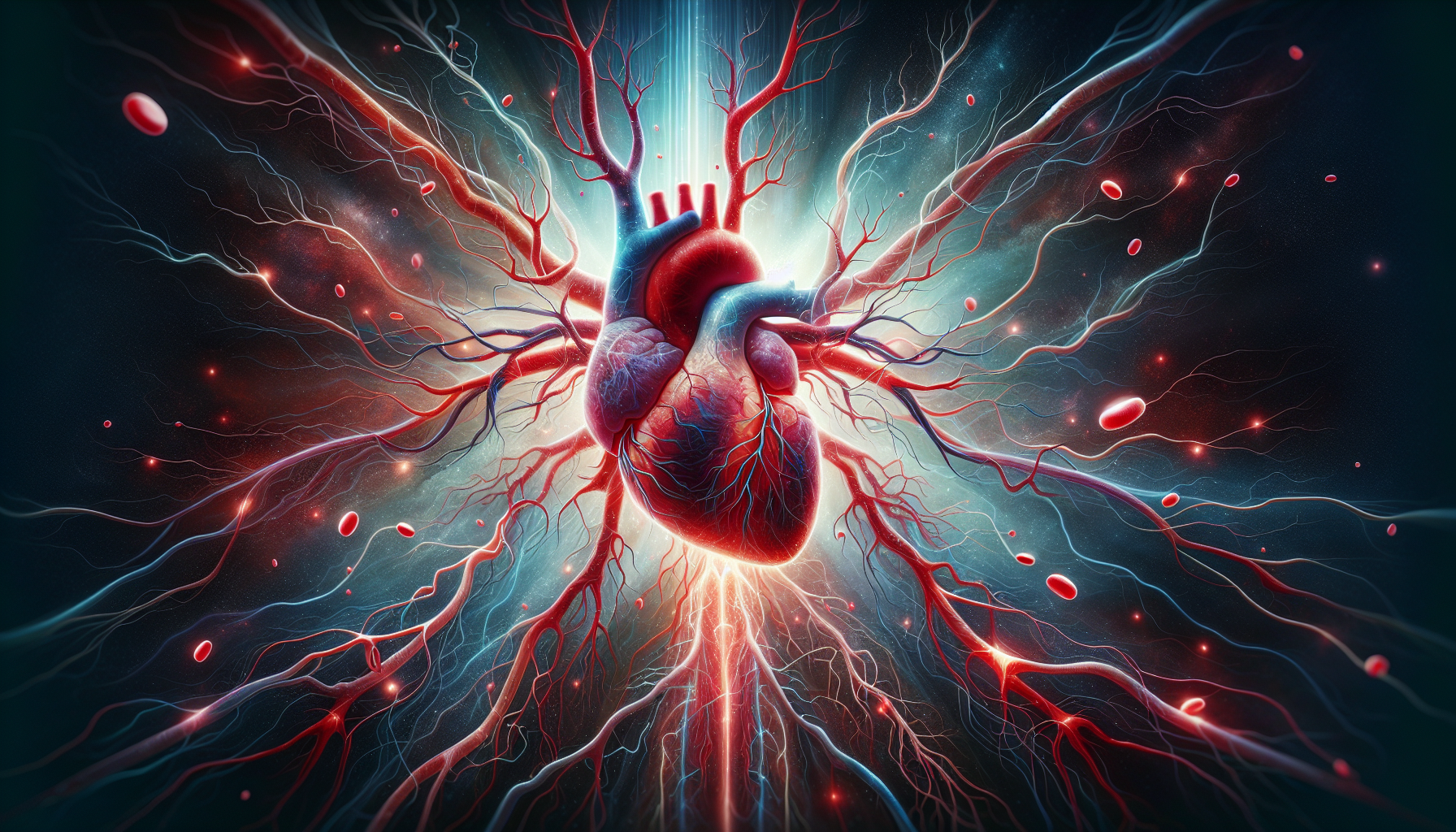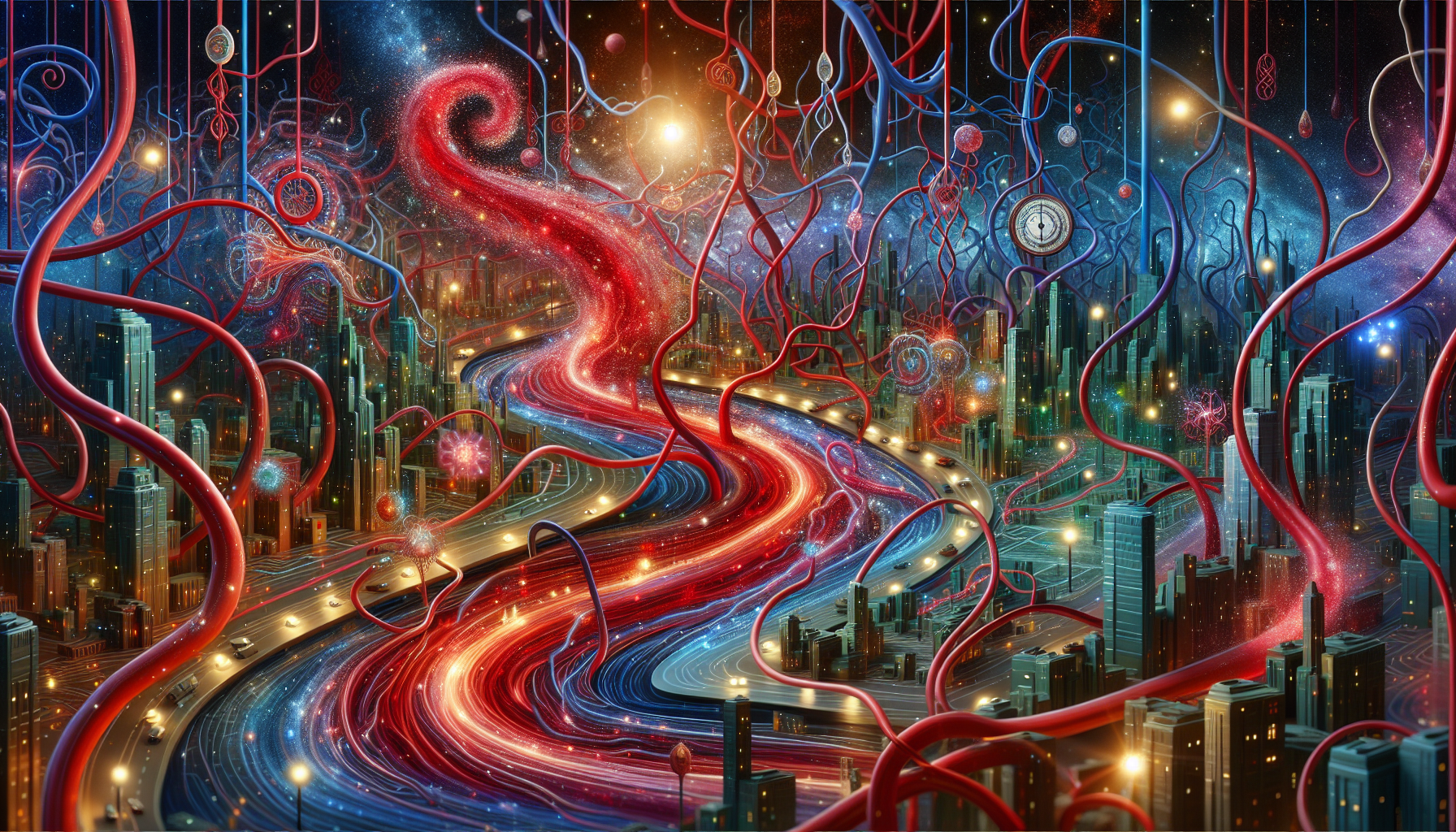Have you ever stopped and wondered about the mind-boggling voyage that the blood coursing through your veins embarks upon each day?
Have you ever thought about the fascinating journey your blood takes through your body, more thrilling than LA traffic?
Well, fasten your seatbelts because we are about to embark on an astonishing journey that's happening right now, inside your very body!
Each day, the roughly 5 liters of blood in your body, travels an impressive distance that, held end-to-end, would encircle our planet twice.
That's the equivalent of a whopping 80,000 kilometers per day!
This tantalizing tale of trek and triumph is not of the fainthearted.
It's a tale set in an intricate network of highways that go beyond the scope of what your GPS can map!
Every single component of your blood assumes the role of an indefatigable hero.
They set forth to wage war against villainous diseases, transport crucial substances to forlorn cells, and recycle waste products like used tickets at the end of a long fair day.
In this blog post, we will unearth the myriad mysteries shrouding this fascinating journey and the tiny, yet, brave fighters that make it possible.
What exactly embarks on this astonishing journey every day?
What makes our blood such an extraordinary transport system and a lethal disease fighter?
Where exactly does your blood go as it courses under your skin, barely noticeable, yet vitally crucial?
Why does this un-ending merry-go-round blood ride, unlike the one at the fair on a fun-filled Sunday, never, ever come to a grinding halt?
Let's delve deep to uncover the secrets at play within the scarlet rivers we so often take for granted.
Let's pull back the curtain on this indispensable journey and the audacious partakers that bring the spectacle of life to a standstill, without ever making it to the limelight.
Welcome to the untold story of your body's captivating circulatory system.
The Intricate Highways: Your Body's Vasculature Network
A well-made painting evokes powerful emotion.
A masterpiece of vascular system, awash with rich hues of life pulsating through your veins, rivals the grandeur of Monet or da Vinci's most aesthetically beautiful creations.
The intricacies of sustaining life unobtrusively are beyond astounding.
Without demur, your blood, racing through 60,000 miles of little highways etching all corners of your body, has a mammoth task at hand every day.
Imagine a miniaturized board game of 'Rush Hour' being conducted in the maze-like network of your body's anatomy.
Only this isn't a game, but a meticulously structured, constantly adapting system playing an enormous role in sustaining life.
Your heart being Grand Central Station initiates the whole sequence, pumping five liters of blood, complete with oxygen and valuable nutrients each minute.
Your arteries, acting like major highways, transport refreshed, oxygen-loaded blood through far-reaching corners of your body.
The robust aorta, your body's main artery collecting blood from the heart, routes the blood to various smaller arteries that tunnel into arterioles, mother arteries' miniature clones.
These arterioles navigate through tissues and finally morph into the fine capillaries, the smallest of the vessels akin tiny streaming brooks.
It is here within the capillaries' miniscule walls, your blood now rich with life's essentials makes the exchange.
Oxygen and nutrients permeate through the capillary walls into surrounding tissues, meanwhile absorbing waste materials, including carbon dioxide.
With a fresh batch of waste-loaded blood, the capillaries merge into venules, the vein versions of arterioles.
Venules converge into veins, growing in size as they approach your heart.
Simultaneously, the waste-laden blood is further collecting waste materials, specifically carbon dioxide that needs to be discharged from the body.
Thus, as the veins return to your heart, they pass through your lungs where an impressive gas exchange happens.
In a fascinating dance of life-sustaining processes, your lungs inhale fresh air, primarily oxygen, and instantly oxygen diffuses across the thin walls of capillaries within the lungs into the blood.
Carbon dioxide, being the waste product diffuses in the opposite direction into the lungs, and is exhaled out.
This purifies the blood from waste and readies it for the next round trip.
Like seasoned globetrotters, your red blood cells perfectly accomplish their mission.
They efficiently travel all round, ejecting oxygen and nutrient supplies, collecting waste, and returning home to get ready for the next voyage.
Surprisingly, the entire circulatory journey completes in mere minutes.
This colossal task, happening ceaselessly, is a refined symphony of physiological processes to which you owe every breath, every heartbeat, every minute.
Isn't it amazing that your blood vessels stretch a distance longer than twice around the Earth's equator, all fitting remarkably within the scope of your body?
This inevitably brings considerable pressure on your vascular system.
To sustain such pressure, your body surely has its unique ways. But how does it ensure a smooth, unhampered circular journey?
What mechanisms are in place to cope with all the potential threats clouding the blood's round-the-clock journey?
Join us as we uncover these fascinating aspects in the next section!
The Remarkable Rhythm: Your Heart as the Maestro

Your heart lies center stage, conducting the symphony that is your circulatory system.
Every minute, this miraculous organ pumps an average of 5 liters of blood throughout your body.
Here's a glimpse into the astonishing journey your blood takes, directed by your heart.
Think of your heart as an intricate symphony conductor, guiding each section, the arteries, veins, and capillaries with precision and rhythm.
The process begins when your heart contracts upper chambers, flipping open two marvelously durable valves which then eject prepared oxygenated blood into arteries meant for the body at large, the beat has started.
But it's not just the solitary beat of the drum; it's the rhythm that matters.
This 'lub-dub' sound you hear through a stethoscope is your heart valiantly pumping blood to every nook and cranny of your body.
The music of your body continues as the outgoing blood, bright red and rich with life-giving oxygen and nutrients, responds to the heartbeat, careening forcefully down the highways of your arteries.
These great routes diverge into smaller arterioles that further devolve into capillaries, the smallest but arguably some of the most essential players in this grand symphony.
Capillaries are where the magic really happens.
They are the meeting place, the intermission. Where oxygen and nutrients exit the blood, making their crucial cameo in the cells before carbon dioxide and other waste products take their seats, getting ready for the journey back.
The capillaries eventually merge into venules, then veins, becoming the return routes for this no longer oxygen-rich, now darker-colored blood.
It is a round trip, and our tired blood, heavy with wastes and short on oxygen, makes its way back to the heart's lower chambers.
The valves shut, causing the second 'dub' sound, then with a forceful contraction, this blue echo is sent lungwards for a breath of fresh air.
The boundless rhythm of circulation is constant, the flow of blood ensuring that every cell gets the service it needs, and every waste product is efficiently removed.
The emotional swell of the strings? That's your digestive system absorbing nutrients from food and releasing them into the bloodstream.
The rumbling of the timpani? It's your kidneys, purifying your blood by sieving out harmful wastes, the unsung heroes that help keep the symphony in tune.
And, in this grand orchestra, perhaps the most unsung heroes of all are the blood cells themselves.
Red blood cells, white blood cells, and platelets each play a distinct role, ensuring the harmony of your overall health.
They participate in repair, fighting infection, clotting, and carrying oxygen. Each one is as important as the notes on a musical score.
But all of this raises the question, what happens when the steady rhythm is lost?
What occurs when the most skilled conductor, the heart starts missing beats, becoming irregular, or worse, stops altogether?
This is where the conversation turns to heart disease, arrhythmias, and other disruptive conditions.
But doesn't this make you wonder what we can do to ensure that the rhythm remains steady and the conductor sturdy?
The Heart: Epicenter of Your Circulatory System

The heart, referred to in many cultures as the symbol of emotion, is ironically a muscular organ devoid of sentimentality but crucial for life itself.
A hub that keeps your blood in constant motion, the heart is the starting point of the blood's daily journey around the body.
So, let's explore the intricate pathways it navigates every moment.
Your heartbeats, often considered as the signature of life, are the direct consequences of the blood being pumped.
But have you ever wondered the staggering amount of work it does in a single day?
An adult human heart on average beats about 100,000 times in one day.
The cardiac output, i.e. the volume of blood that it pumps in a minute, amounts to approximately 5 liters, which equates to nearly 7,200 liters of blood in a day!
From circulating oxygen and nutrients to transporting waste products and hormones, the heart is tirelessly working even when you are at rest.
So, how does this expedition of the blood begin?
How does this crimson river navigate through your body?
Here's the answer to these compelling questions.
It starts with two main pathways, systematically orchestrated by your heart.
These paths are named the Pulmonary and Systemic Circuits.
Initially, the blood gets pumped from the heart to the lungs through the Pulmonary Circuit.
This is where the blood releases carbon dioxide, a waste product, and absorbs oxygen.
This renovated, oxygen-rich blood is then pumped back to the heart.
Once the refreshed blood is back in the heart, it's time for it to embark on its epic voyage, the Systemic Circuit.
Now, the oxygen-rich blood is pumped from the heart to the rest of the body. This is when the incredible distribution of oxygen, nutrients, hormones takes place, feeding every single cell in your body.
After dispensing their cargo, and gathering waste materials and carbon dioxide, our 'blood couriers' return to the heart, ready to begin the journey anew!
Now, this journey may seem to be seamless and without any bumps, but that's not entirely true.
The intricate field of tiny vessels called capillaries, where the exchange of oxygen, nutrients, and wastes takes place, is exceptionally delicate. These capillaries, which are thinner than a hair strand, are fragile. Yet, surprisingly resilient, they are able to withstand the powerful surge of life coursing through them.
The paramount role of the heart, and subsequently blood, is a testament to the extraordinary wonders of our bodies.
Yet we rarely consider its systematic rhythms and tireless service until it falls silent, a silence we never wish to encounter.
Let's remember that a healthy heart is the first step towards a healthy life. And to achieve this we should try and do the following three things:
Regular exercise
Balanced diet
Keep stress at bay
Having journeyed through this vast, pulsating network, it's worth remembering that blood is more than just a vehicle for carrying oxygen and waste. It defends the body, regulates our temperature, and much more.

